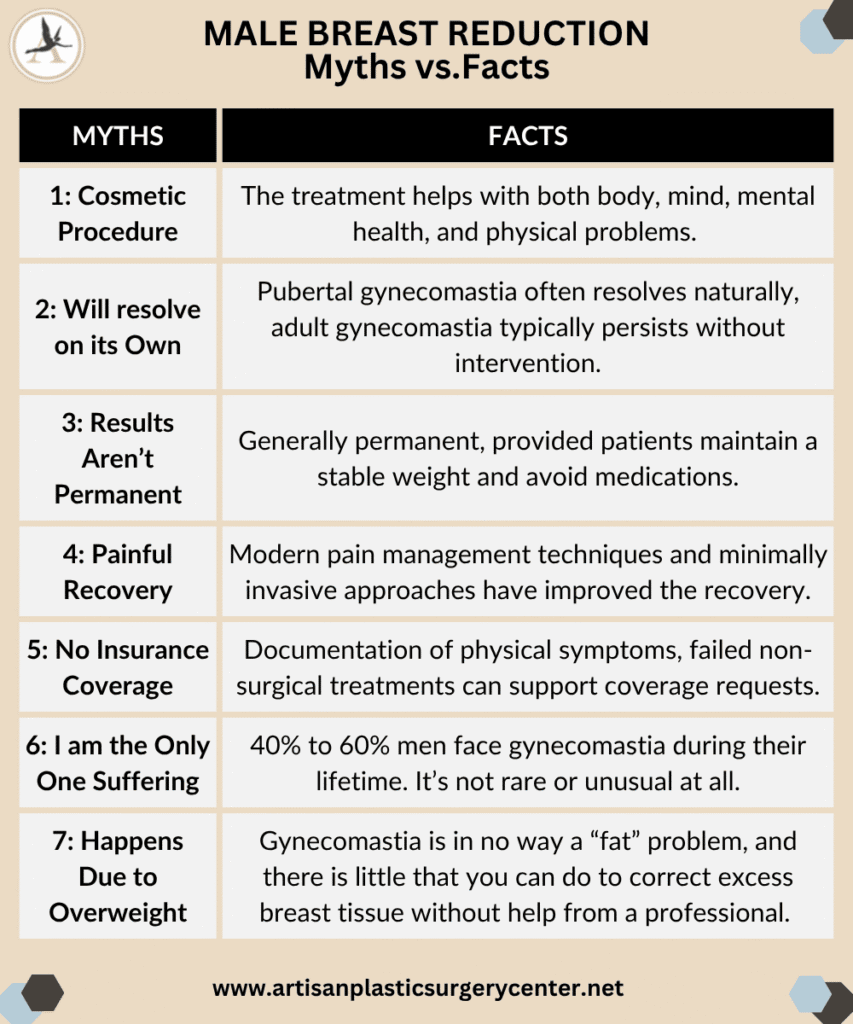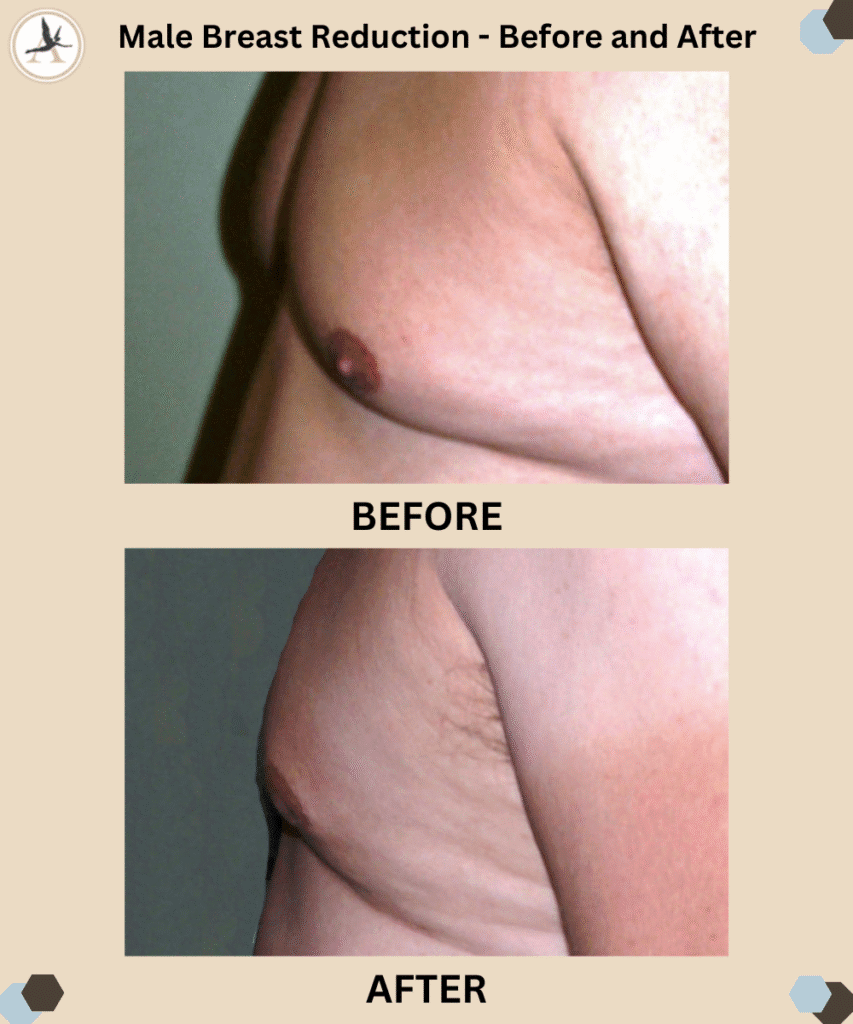Many men had a perception that gynecomastia, or man boobs, happens because they have a heavier body weight or don’t work out enough. The truth is that hormone problems are usually behind this condition. This post dispels male breast reduction misconceptions and myths. And explains the facts about treatment options and outcomes.
Male Breast Reduction Misconceptions – The Key Takeaways
Gynecomastia, the presence of enlarged breasts in men, is a relatively new topic of discussion. Men who have enlarged breasts often feel alone and embarrassed. Many don’t talk about this condition called gynecomastia. It remains a hidden problem because most guys feel too shy to discuss it with their friends. This has been going on for many years and affects more men than you might think. This guide addresses common male breast reduction misconceptions and myths. While providing essential facts about Gynecomastia surgery in Tampa, Florida. Here are a few common misconceptions and myths:
- Misconception 1: Male Breast Reduction is Just Cosmetic.
- Misconception 2: The Condition will resolve on its Own.
- Misconception 3: Results Aren’t Permanent.
- Misconception 4: Recovery is Extremely Painful.
- Misconception 5: Insurance Never Covers the Procedure.
- Misconception 6: I am the Only One with this Problem.
- Misconception 7: It Must Be Because I Have a Heavier Body Weight.
- Misconception 8: Everyone Will Know I Had Something Done.

Male Breast Reduction Misconceptions – What is Gynecomastia?
Male breast reduction surgery (gynecomastia surgery) is becoming increasingly common, yet many misconceptions persist about this procedure. Upon meeting prospective patients, I’ve found that there are many misconceptions about male breast reduction surgery. Slowly, however, men are becoming more comfortable talking with a trusted plastic surgeon such as Tampa’s Dr. Castor.
Male breast enlargement, also known as gynecomastia, is a common issue that affects many men. The condition makes breast tissue grow bigger than normal in males. About one in three men will deal with this at some point. There are several reasons why this happens. Sometimes it’s due to changes in hormone levels. Other times, it can be a side effect of certain drugs.
Weight gain can also make the chest look bigger. In some cases, men inherit this trait from their family members. The good news is that this condition is well understood by doctors. Most men who notice breast tissue growth should know that they are not alone in dealing with this issue. While not typically a health risk, gynecomastia can cause significant psychological distress, including embarrassment, self-consciousness, and avoidance of physical activities.
Male Breast Reduction Misconceptions – Procedure Misconceptions
Misconception 1: Male Breast Reduction is Just Cosmetic
Reality: While aesthetic improvement is a significant benefit, many men with gynecomastia experience physical discomfort, skin irritation, and psychological distress. The treatment helps with both body and mind issues. It works on fixing physical problems while also dealing with mental health concerns. This complete approach makes sure patients get better in all ways. The method is straightforward and tackles every part of the problem.
Misconception 2: The Condition Will Resolve On its Own
Reality: While pubertal gynecomastia often resolves naturally, adult gynecomastia typically persists without intervention. Lifestyle changes may help when the condition is primarily fat-related, but cannot address true glandular enlargement.
Misconception 3: Results Aren’t Permanent
Reality: Male breast reduction results are generally permanent, provided patients maintain a stable weight and avoid medications that contribute to gynecomastia. The removed glandular tissue cannot regrow.
Misconception 4: Recovery is Extremely Painful
Reality: Patients usually feel some soreness and aches instead of really bad pain. The feeling is uncomfortable but not too intense. Most can handle it without much trouble. Modern pain management techniques and minimally invasive approaches have significantly improved the recovery experience. Furthermore, gain insights into gynecomastia causes, surgical and non-surgical options, and a recovery guide.
Misconception 5: Insurance Never Covers the Procedure
Reality: While often considered cosmetic, insurance may cover male breast reduction when medical necessity can be demonstrated. Documentation of physical symptoms, failed non-surgical treatments, and psychological impact can support coverage requests.
Misconception 6: I Am the Only One with this Problem
Reality: More often than not, men feel isolated in their struggle with gynecomastia. Many men deal with large breasts that affect their self-esteem. This is a common issue that impacts how they feel about their bodies. This couldn’t be farther from the truth.
Research shows that about 40% to 60% men face this condition called gynecomastia during their lifetime. It’s not rare or unusual at all. Lots of men go through this same challenge. The good news is that they’re not alone, and there are ways to handle it. This problem can show up at different times in life and affects men of all ages and backgrounds.
According to the American Society of Plastic Surgeons (ASPS), over 24,000 male breast reduction procedures are performed annually in the United States, representing a 30% increase over the past decade. This growing trend reflects both increased awareness and reduced stigma surrounding the condition.
Misconception 7: It Must Be Because I Have a Heavier Body Weight
Reality: Gynecomastia is in no way a “fat” problem, and there is little that you can do to correct excess breast tissue without help from a professional. Men of all shapes and sizes can develop gynecomastia at any age. While I always encourage a healthy diet and lifestyle, it is likely to have little impact on the size of your breasts. Some exercises may make the male breasts even more prominent.
Instead, gynecomastia is more often the result of factors over which we have little control over including genetics, a hormonal imbalance, or a medical condition. Certain medications are also believed to increase the formation of excess breast tissue.
Misconception 8: Everyone Will Know I Had Something Done
Reality: No one needs to know but you. I’m careful to use the utmost discretion as he plans and performs your breast reduction. During your surgery, I will use advanced techniques, such as VASER® Liposelection, to remove the excess fat and glandular tissue without extensive surgery. If an incision is needed, Dr. Castor will carefully make it around the areola of the nipple as to be sure that it is not noticeable once it has fully healed.
The surgery itself generally lasts one to two hours. Men can return home following their surgery. While it is wise to take it easy and let the body heal, most men can go back to work within a few days.
Male Breast Reduction Misconceptions – Procedure and Surgical Techniques
1. Liposuction
For cases primarily involving excess fatty tissue, liposuction may be sufficient. This minimally invasive technique removes fat through small incisions, resulting in minimal scarring and relatively quick recovery times.
2. Surgical Excision
When glandular breast tissue is the primary concern, surgical excision becomes necessary. This technique allows the surgeon to remove glandular tissue and excess skin that liposuction alone cannot address.
3. Combined Approach
Many patients benefit from a combined approach, utilizing both liposuction and surgical excision to achieve optimal results. This comprehensive technique addresses both excess fat and glandular tissue for a more natural-looking chest contour.
Male Breast Reduction Misconceptions – Important Considerations
1. Scheduling Consultation
You should meet with a qualified plastic surgeon to discuss your options. This important first step helps you understand the procedure and make sure it’s right for you. During this appointment, your surgeon will evaluate your condition, discuss your goals, and recommend the most appropriate surgical approach.
2. Undergoing Pre-operative Testing
Before your surgery, you will need to complete some basic medical tests. The surgeon will take blood samples and do a full checkup of your body. You might also need a breast scan, like a mammogram or ultrasound. These tests help make sure there are no other health issues to worry about. The medical team needs to know everything is okay before they can start the operation.
3. Setting Realistic Expectations
Understanding what male breast reduction can and cannot achieve is crucial for satisfaction with your results. While the procedure can significantly improve chest contour, factors such as skin elasticity and overall body composition will influence your outcome.
Male Breast Reduction Misconceptions – What to Expect During and After Surgery
Before surgery, you’ll receive detailed instructions regarding medication adjustments, fasting requirements, and other preparations. Post-procedure guidelines will cover wound care, activity restrictions, and follow-up appointments.
1. Anesthesia
Male breast reduction is typically performed under general anesthesia or local anesthesia with sedation, ensuring you remain comfortable throughout the procedure.
2. Incision
Incision patterns vary based on your surgical plan. Liposuction needs just a small incision in the skin. But removing breast tissue requires bigger cuts. These cuts are made either around the nipple area or along the natural fold lines of the chest.
3. Recovery
Most patients return to light activities within a few days and resume normal activities within 2-3 weeks. Complete healing and final results may take several months as swelling subsides and tissues settle.
4. Before and After Results
Men who get breast reduction surgery are usually very happy with their results. Most patients feel much better about themselves after the procedure and enjoy a more confident lifestyle. Their body image improves & they often find daily activities more comfortable. The surgery helps them feel more at ease in social situations and when wearing different types of clothing.
Before and after photos demonstrate the dramatic transformation possible, though individual results vary based on starting anatomy and surgical technique. Besides this, view our before-and-after gallery and the number of transformations Dr. Castor and his team have performed.

Male Breast Reduction Misconceptions – Procedure FAQs
How long does male breast reduction surgery take?
Typically 1-3 hours, depending on the extent of tissue removal and techniques used.
Will I have visible scarring?
Incision placement prioritizes scar concealment. Most scars fade significantly over time and are placed in natural contours or around the areola.
When can I return to exercise after surgery?
Light cardio may resume after 2 weeks, with full exercise, including chest workouts, typically cleared at 6 weeks.
Can gynecomastia return after surgery?
Recurrence is rare when the procedure is performed correctly. Maintaining a healthy lifestyle helps ensure lasting results.
How do I know if I’m a good candidate?
Ideal candidates are in good overall health, at a stable weight, have realistic expectations, and have persistent gynecomastia that hasn’t responded to non-surgical approaches.
Is gynecomastia caused by poor diet or lack of exercise?
Not always. Hormones in your body are usually the reason for this problem, not the way you live your life. The issue comes from inside your body rather than from your daily habits.
Do men lose sensation after surgery?
Temporary numbness is possible, but most sensation returns over time.
Will there be visible scars?
Dr. Castor uses discreet incisions to minimize visible scarring.
Male Breast Reduction Misconceptions – Gynecomastia Solution at Artisan Aesthetics
Male breast reduction (gynecomastia surgery) corrects excess male breast tissue or fat. Addressing misconceptions (not simply fat, not only for bodybuilders) helps men understand realistic outcomes and candidacy.
At Artisan Aesthetics, we’re committed to providing comprehensive care for men seeking male breast reduction. By addressing these misconceptions and providing accurate information, we hope to help you make an informed decision about whether the male breast reduction procedure is right for you.
Don’t let your chest get the best of you any longer. As a board-certified plastic surgeon, I have helped many individuals achieve a flat, masculine chest. Reach out to us at (813) 971-2000 or schedule your no-obligatory initial complimentary consultation to discuss your treatment options.

